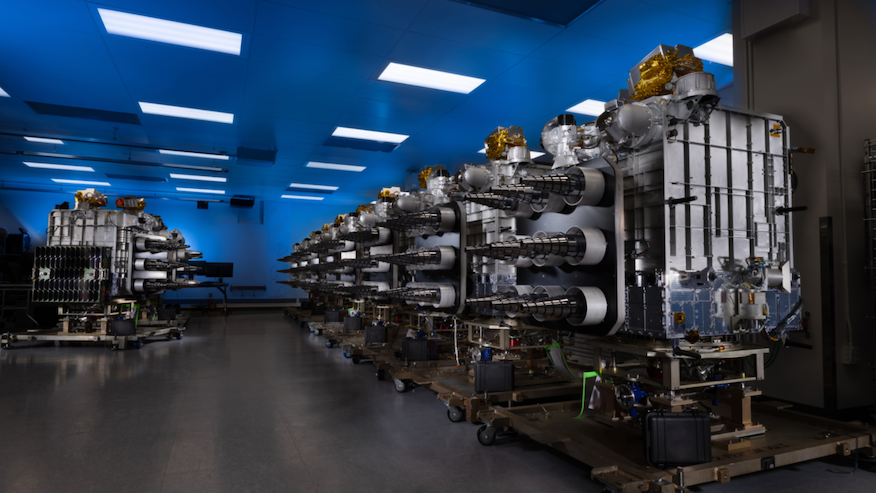SpaceX Launches Second Batch of Satellites for Space Development Agency Following Weather Scrub – Spaceflight Now

Update October 15, 7:38 p.m. EDT (11:38 p.m. UTC): SpaceX has landed its booster on the drone.
Update October 14, 6:45 p.m. EDT (10:45 p.m. UTC): SpaceX canceled Tuesday’s launch attempt due to bad weather.
The Space Development Agency has added 21 more satellites to its growing constellation in low Earth orbit with a launch aboard a SpaceX Falcon 9 rocket. This is the second of ten launches booked so far by the SDA aboard the Falcon 9.
The T1TL-C mission was the second flight supporting what the SDA calls its Tranche 1 transport layer. It is the final element of a satellite constellation dubbed the Proliferated Warfighter Space Architecture (PWSA).
“The mission we have been doing for six and a half years is to provide capabilities to warfighters,” Gurpartap Sandhoo, deputy director of the SDA, said during a pre-launch media roundtable in September.
“In 2019, when the SDA was created, [the goal] It was about doing two things: One was to make sure that we can go beyond line-of-sight targeting and be able to place the threat, the emerging threat, within the range of the warning missile trajectory. »
SpaceX launched the T1TL-C mission from Space Launch Complex 4 East at Vandenberg Space Station on Wednesday, October 15 at 4:06 p.m. PDT (7:06 p.m. EDT/2306 UTC). The rocket followed a southward trajectory after leaving the California coast.
SpaceX used its Falcon 9 B1093 first stage booster to launch this mission. Its most recent flight was the SDA’s T1TL-B mission in September and it has also participated in five Starlink missions.
Nearly nine minutes after takeoff, B1093 landed on SpaceX’s drone ship, “Of Course I Still Love You,” which was positioned in the Pacific Ocean. This was SpaceX’s 49th flight from California so far this year.
Increase in military capabilities
The 21 satellites on board the T1TL-C mission were manufactured by Lockheed Martin. They will join York Space Systems’ first 21 satellites, launched as part of the T1TL-B mission, currently in orbit.
These two companies, along with Northrop Grumman, have been awarded contracts to build this part of the PWSA satellite constellation, which will include 126 satellites in total. After the launch in September, Col. Ryan Hiserote, chief of the U.S. Space Force’s Space Systems Command division within the Assured Access to Space Directorate, said Northrop Grumman’s satellites would fly on the upcoming T1TL-A mission.

“The first three missions (A, B and C) in terms of their launch order are interchangeable,” Hiserote said in a statement to Spaceflight Now.
Tranche 1 also includes what the SDA calls a tracking layer, which will consist of 28 satellites and four missile defense demonstration satellites “equipped with optical communications terminals and Ka-band radio frequency receive/transmit capability,” according to the SDA.
The SDA plans to launch approximately one mission per month to support its constellation. After each launch, the SDA will conduct initial checks and expects these satellites to be operational for their first users within approximately four to six months.
This first constellation is designed to “serve as the initial warfighting capability for the Proliferated Warfighter Space Architecture (PWSA) and provide regional persistence for Link-16 and Ka-band military tactical communications, advanced missile tracking and missile warning, and beyond-line-of-sight targeting.”
Sandhoo said the plan is that by January 2027, U.S. Indo-Pacific Command, the unified combatant command over the globe’s Indo-Pacific region, will be able to begin reliably using the capabilities provided by the Tranche 1 constellation.
“Space has always been a nebulous thing that people need to understand and rely on. So that’s the whole goal of this team is to integrate that into day-to-day operations, so that the joint force understands and can exploit that capability and the Space Force can also present those forces to the joint force across the space layer,” Sandhoo said.
“It’s like any new capability brought into the fleet, it takes time, effort, experimentation and exercises to get them all up to speed and start using it,” he added. “So that’s our goal for the next couple of years, at least once we have established that regional capacity.”



